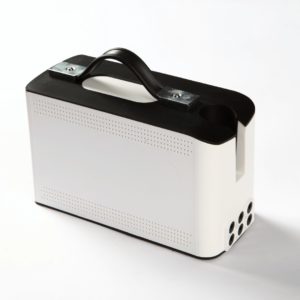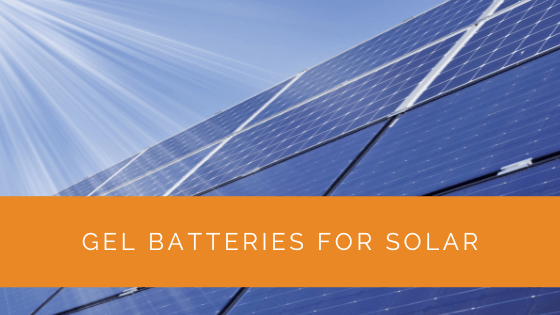When it comes to solar batteries, there is an ongoing debate between gel batteries and AGM batteries. Since no two solar installations are the same, many factors, like the climate and discharge rates, impact your choice of solar batteries.
For instance, if you are designing off-grid solar systems, you may be required to select suitable batteries for your solar panel system carefully.
To help you with this, we will help you identify the differences between a gel battery and an AGM battery in this article. So, let’s get started!
Contents
- 1 Key Takeaways
- 2 What Are Gel Batteries?
- 3 What Are AGM Batteries?
- 4 Types of Battery Systems
- 5 How to Choose Your Solar Batteries?
- 6 Case Study: Enhancing Off-Grid Solar Systems with Gel Batteries
- 7 Expert Insights from Our Solar Panel Installers About Gel Solar Batteries
- 8 Experience Solar Excellence with Us!
- 9 Wrapping Up
Key Takeaways
- Gel and AGM batteries are lead-acid batteries used in solar installations, each with advantages. Gel batteries have silica in the electrolyte mixture, providing extra power and long-term energy storage benefits. AGM batteries are sealed, maintenance-free, and perform better with minimal gassing and acid leakage.
- The choice between gel and AGM batteries depends on your specific solar system needs. Off-grid systems, which operate independently from the grid, often use deep cycle batteries like gel or AGM batteries to store energy generated during the day for nighttime use. Grid-tied systems, on the other hand, use battery backups only during power outages.
- Careful selection of the appropriate battery type, such as gel batteries, is crucial for the success and longevity of your solar energy system, as mistakes can lead to damage. Regular maintenance and monitoring ensure a longer lifespan for your solar system.
What Are Gel Batteries?
Gel batteries are lead-acid batteries with silica inside the electrolyte mixture, which helps create a gel-like substance. In such batteries, the electrolytes stand solid between the positive and negative plates.
So, if you have a lead-acid battery housing, then gel batteries are beneficial in providing extra power to your overall battery system. They also come with many other benefits for long-term energy storage.
What Are AGM Batteries?
Absorbed glass mat (AGM) batteries are a type of sealed lead-acid batteries that are used for solar storage options. These batteries are resistant to vibration, are sealed, and maintenance-free.
Compared to traditional valve-regulated lead-acid VRLA batteries, they offer better performance, minimal gassing, and less acid leakage. Additionally, they are compatible with solar electric vehicles and are excellent energy storage options for anyone looking for sustainable alternatives.
Thus, AGM and gel batteries are lead-acid batteries and are different from lithium-ion batteries. However, lead-acid batteries are more commonly preferred as a backup energy source for solar panels as they increase the battery life of the solar storage.

Types of Battery Systems
There are two main types of battery systems- grid-tie with battery backup and off-grid systems.
Off-Grid Systems
An Off-grid system is a type of battery system independent of grids. During days when the sunlight isn’t sufficient, for example, on cloudy days or at night, the solar power system of the house depends on the batteries.
In these systems, the highest amount of electricity is generated during the peak hours of the daytime when the solar light is maximum, while the highest consumption of this generated electricity occurs at night.
For the electricity to last all night or even longer on days when the sunlight is insufficient, the battery bank must be fully charged during the peak hours of solar light. As such, the batteries designed for such type of functioning are deep cycle batteries. This means they charge throughout the day and deep discharge at night.
Under this category, the most common types of batteries produced are flooded batteries, AGM, and gel lead-acid batteries.
Grid-Tied System
The grid-tied system works with the help of a battery backup only during a power outage. Under the regular functioning of this system, the DC power from the solar panels passes through a grid-tier inverter that converts it to AC.
With the help of this power, the panels can run appliances in your home. Simultaneously, some amount of this electricity can also charge the battery bank. So, during a power outage, when the inverter disconnects itself from the grid, your home’s electricity supply will run as an off-grid system.
How to Choose Your Solar Batteries?
Lead-acid (gel-based or AGM) batteries are the most commonly preferred battery type, especially if you decide to go for an off-grid system. But when it comes to choosing between the two, it is important to remember that each type has advantages and disadvantages.
For instance, gel batteries are specialized in deep-cycle batteries. They are sturdy and low-maintenance, and the electrolyte inside the battery prevents the cell from leaking in case of any damage. However, they are also slightly expensive and discharge faster than flooded batteries.
Case Study: Enhancing Off-Grid Solar Systems with Gel Batteries
Background
The Carter family, living in a remote area of Arizona, decided to install a solar power system to reduce their reliance on the grid and promote sustainable living. Given their location, they needed a reliable battery system to store energy generated during the day for use at night and on cloudy days.
Project Overview
The primary goal was to design an off-grid solar system for the Carter family that could handle their daily energy needs while providing a reliable power source during periods of low sunlight.
Implementation
Initial Assessment and Requirements
Our team conducted a thorough assessment of the Carter family’s energy consumption patterns and the average sunlight availability in their area. Based on this data, we determined that gel batteries would be the most suitable for their needs due to their long lifespan and efficiency in deep-cycle applications.
Recommendation and Solution
We recommended the following components for their off-grid solar system:
- Solar Panels: 5kW of monocrystalline solar panels for maximum efficiency.
- Gel Batteries: A bank of gel batteries with a total storage capacity of 20kWh.
- Inverter: A high-efficiency inverter to convert DC to AC power for household use.
- Charge Controller: To manage the flow of energy from the solar panels to the batteries and prevent overcharging.
Installation Process
- System Design: Created a detailed design plan outlining the placement of solar panels and the configuration of the battery bank.
- Procurement and Preparation: Sourced high-quality gel batteries and other system components.
- Installation:
- Solar Panels: Mounted the solar panels on the rooftop for optimal sunlight exposure.
- Battery Bank: Installed the gel batteries in a ventilated, weather-protected area.
- Inverter and Charge Controller: Connected and configured these components to ensure efficient energy conversion and storage.
- Testing and Training: Conducted comprehensive testing to ensure the system met performance expectations and provided the Carter family with training on system operation and maintenance.
Results
The installation of the off-grid solar system with gel batteries provided several benefits for the Carter family:
- Reliable Power Supply: The gel batteries ensured a steady power supply, even during extended periods of low sunlight.
- Reduced Energy Costs: The family significantly lowered their electricity bills by relying on solar energy for their daily needs.
- Sustainability: By using solar power, the Carters reduced their carbon footprint and contributed to environmental sustainability.
- Low Maintenance: The gel batteries required minimal maintenance, providing hassle-free operation.
Summary
This case study demonstrates the effectiveness of gel batteries in off-grid solar systems. The successful implementation highlights how gel batteries’ durability and efficiency can enhance energy reliability and sustainability for remote households.
Expert Insights from Our Solar Panel Installers About Gel Solar Batteries
Gel batteries are particularly effective in off-grid solar systems due to their durability and low maintenance requirements. Their ability to provide long-term energy storage makes them ideal for areas with variable sunlight.
– Solar Battery Specialist
When choosing between gel and AGM batteries, consider the specific needs of your solar installation. Gel batteries offer a stable and reliable energy source, especially in extreme temperatures, but AGM batteries are easier to maintain and install.
– Renewable Energy Consultant
For homeowners new to solar energy, gel batteries are an excellent choice due to their robust design and efficiency in deep-cycle applications. They ensure a consistent power supply even during prolonged periods without sunlight.
– Solar Installation Expert
Experience Solar Excellence with Us!
Trust in Solar Panels Network USA, where our seasoned experts deliver top-quality solar solutions for homes and businesses nationwide. With a legacy of countless successful installations and a commitment to sustainable energy, we’re your reliable partner in the solar journey. Ready for a brighter, eco-friendly future? Call us now at (855) 427-0058 and harness the sun’s power!
Wrapping Up
Solar electricity is a one-of-a-kind experience, and the type of system you choose to go for defines it even further for you. Hence, you must carefully select your battery bank, as some mistakes could lead to severe damage.
As we all know, solar energy is a step towards an eco-friendly life; therefore, maintaining and monitoring your system regularly will ensure a longer lifespan of the system.
So, what’s the hold? Invest in gel batteries for all your energy requirements!
About the Author
Solar Panels Network USA stands at the forefront of solar energy solutions, driven by a team of seasoned solar engineers and energy consultants. With over decades of experience in delivering high-quality solar installations and maintenance, we are committed to promoting sustainable energy through customer-centric, tailored solutions. Our articles reflect this commitment, crafted collaboratively by experts to provide accurate, up-to-date insights into solar technology, ensuring our readers are well-informed and empowered in their solar energy decisions.

